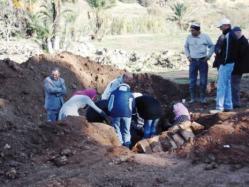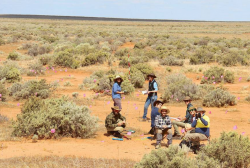INSTITUT SUPERIEUR D'ANTHROPOLOGIE
INSTITUTE OF ANTHROPOLOGY
ONLINE COURSES / COURS A DISTANCE
WINTER TERM : JANUARY 2014
REGISTER NOW
ALGERIE –  Hammam Debagh - Huit tombes sous tuiles de l’époque romaine ont été découvertes, jeudi dernier, à Hammam Debagh (Ex-Hammam Meskhoutine), commune située à une vingtaine de kilomètres à l’ouest de Guelma. C’est un groupe de trois archéologues du centre national de recherches en archéologie (CNRA), en mission de diagnostic depuis le 10 décembre sur un site devant accueillir 3 hôtels, dont un de 5 étoiles. Sur les lieux de la découverte, en contrebas du site classé naturel de Hammam Débagh, mondialement connu de par son appellation Hammam Meskhoutine (littéralement bain des maudits), les archéologues étaient à pied d’œuvre. A ce sujet le chef de cette mission nous déclare : «C’est à la demande de la direction de la culture de la wilaya de Guelma que cette mission de sondage et de diagnostic a été diligentée par le CNRA. Nous avons effectué depuis notre arrivée 12 sondages, de 12x2 mètres chacun, sur ce site devant accueillir des projets de construction d’hôtels. Les deux derniers sondages ont été fructueux, puisque nous avons découvert huit tombes de type sous tuiles d’époque romaine.» Et d’ajouter: «Nous sommes sur le site de Aqua Tibilitana. Les autorités locales auraient dû faire appel au CNRA pour un diagnostic, avant l’attribution des projets d’hôtellerie.» Et de conclure : «Quant aux citernes d’époque romaine, en amont, bien que visibles avant le terrassement et complètement mises à nu après les travaux des engins, elles sont proposées d’emblée pour un projet d’intégration.»
Hammam Debagh - Huit tombes sous tuiles de l’époque romaine ont été découvertes, jeudi dernier, à Hammam Debagh (Ex-Hammam Meskhoutine), commune située à une vingtaine de kilomètres à l’ouest de Guelma. C’est un groupe de trois archéologues du centre national de recherches en archéologie (CNRA), en mission de diagnostic depuis le 10 décembre sur un site devant accueillir 3 hôtels, dont un de 5 étoiles. Sur les lieux de la découverte, en contrebas du site classé naturel de Hammam Débagh, mondialement connu de par son appellation Hammam Meskhoutine (littéralement bain des maudits), les archéologues étaient à pied d’œuvre. A ce sujet le chef de cette mission nous déclare : «C’est à la demande de la direction de la culture de la wilaya de Guelma que cette mission de sondage et de diagnostic a été diligentée par le CNRA. Nous avons effectué depuis notre arrivée 12 sondages, de 12x2 mètres chacun, sur ce site devant accueillir des projets de construction d’hôtels. Les deux derniers sondages ont été fructueux, puisque nous avons découvert huit tombes de type sous tuiles d’époque romaine.» Et d’ajouter: «Nous sommes sur le site de Aqua Tibilitana. Les autorités locales auraient dû faire appel au CNRA pour un diagnostic, avant l’attribution des projets d’hôtellerie.» Et de conclure : «Quant aux citernes d’époque romaine, en amont, bien que visibles avant le terrassement et complètement mises à nu après les travaux des engins, elles sont proposées d’emblée pour un projet d’intégration.»
http://www.elwatan.com/regions/est/actu-est/sur-les-traces-de-aqua-tibilitana-22-12-2013-239430_221.php
AUSTRALIE –  Ned’s Corner Station- A major, seven-year archaeological project has begun on Ned’s Corner Station, on the Murray floodplain west of Lake Culleraine, and has already found evidence of 15,000 years of human occupation. And La Trobe University archaeologist Dr Jillian Garvie, who led the three-week survey, believes the floodplain will eventually yield evidence of much earlier human occupation, dating back some 40,000 years. “If there were people at Lake Mungo 40,000 years ago, there’s no reason why they wouldn’t have been living across a far more extensive region of north-western Victoria and south-western NSW,” Dr Garvie said.
Ned’s Corner Station- A major, seven-year archaeological project has begun on Ned’s Corner Station, on the Murray floodplain west of Lake Culleraine, and has already found evidence of 15,000 years of human occupation. And La Trobe University archaeologist Dr Jillian Garvie, who led the three-week survey, believes the floodplain will eventually yield evidence of much earlier human occupation, dating back some 40,000 years. “If there were people at Lake Mungo 40,000 years ago, there’s no reason why they wouldn’t have been living across a far more extensive region of north-western Victoria and south-western NSW,” Dr Garvie said.
http://www.sunraysiadaily.com.au/story/1994428/digging-deep-into-history/?cs=1511#slide=1
TURQUIE –  Antandros - Artworks that have been discovered during excavation works in the ancient city of Antandros in Altınoluk, in the northwestern province of Balıkesir’s Edremit district, will be moved to a museum. The head of the Association for Rescue and Protection of Antandros Ancient City, Mehmet Sakaroğlu, said excavations had been ongoing for 13 years in the region, where Paris gave the apple to Aphrodite in mythology, and they needed a museum to display the artworks discovered there.Research that discovered the Antandros Ancient City started in the mid-19th century when a written statement, which mentions the name of Antandros, was found on the wall of the Avcilar village mosque. It was then discovered that Antandros city had been located on Kaletasi hill, 215 meters above sea level. Despite the contradictory information about the establishment of Antandros Ancient City, it is known that Lydian King Alyattes’ son Kroisos ended the occupation of Kimmer in 508 B.C. Antandros was put under the command of Persians after being occupied by Otanes, one of commanders of Persian King Dareios.
Antandros - Artworks that have been discovered during excavation works in the ancient city of Antandros in Altınoluk, in the northwestern province of Balıkesir’s Edremit district, will be moved to a museum. The head of the Association for Rescue and Protection of Antandros Ancient City, Mehmet Sakaroğlu, said excavations had been ongoing for 13 years in the region, where Paris gave the apple to Aphrodite in mythology, and they needed a museum to display the artworks discovered there.Research that discovered the Antandros Ancient City started in the mid-19th century when a written statement, which mentions the name of Antandros, was found on the wall of the Avcilar village mosque. It was then discovered that Antandros city had been located on Kaletasi hill, 215 meters above sea level. Despite the contradictory information about the establishment of Antandros Ancient City, it is known that Lydian King Alyattes’ son Kroisos ended the occupation of Kimmer in 508 B.C. Antandros was put under the command of Persians after being occupied by Otanes, one of commanders of Persian King Dareios.
http://www.hurriyetdailynews.com/the-ancient-city-where-paris-gave-aphrodite-the-apple-in-greek-mythology-seeks-sponsor.aspx?pageID=238&nID=60240&NewsCatID=375